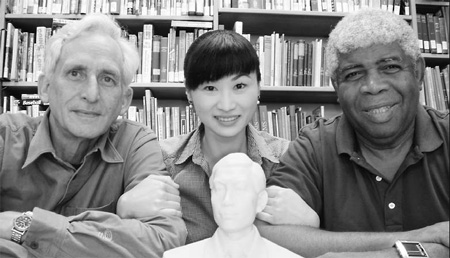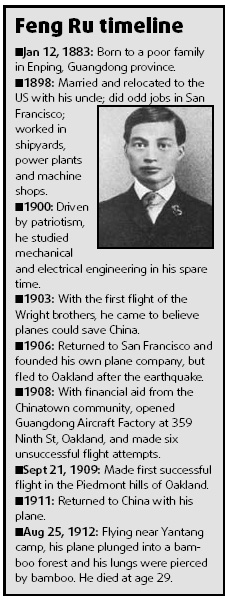In the twilight of Sept 21, 1909, Feng Ru (1883-1912) climbed into a self-propelled, fixed-wing plane he personally designed and prepared for a test flight in the Piedmont hills overlooking Oakland, California. It was six years after the Wright brothers took to the skies, and aviation had just become a global infatuation.
Feng, a self-taught inventor originally from Enping, Guangdong province, flew the plane and stayed aloft for 29 minutes before plunging to the ground.
Following his success as the first person to fly over North America's Pacific Coast, Feng, who is called the "Father of Chinese Aviation", returned to China with his plane. He helped launch the country's aviation industry, a lasting legacy that has grown ever stronger over the past century.
|

|
|
Americans Steven Lavoie (left) and Roger Glenn (right) are determined to commemorate the 100th anniversary of the successful flight of Feng Ru, "Father of Chinese Aviation". [Courtesy of Zhang Qing] |
This year marks the 100th anniversary of his historic flight. At the location where Feng first took to the skies, a chance encounter with Roger Glenn, an African-American jazz performer and private pilot, involved Zhang Qing in the centennial commemoration.
Zhang, a correspondent in Oakland with Hangzhou-based Qianjiang Evening News, was curious about the NASA jacket Glenn wore to their friend's birthday party.
|

|
|
Feng Ru made his successful flight in the Piedmont hills of Oakland on Sept 21, 1909. [documentary photo from China Daily] |
Conversation was then naturally steered toward Glenn's early days of learning to fly in the Hawaii navy, his appreciation of the Chinese aviation pioneer and the project he was working on to commemorate the 100th anniversary of his flight.
"My central motivation for working on this project is that people in this country don't know of him because he was from China at a time when the achievements of minorities in this country were not usually recognized," Glenn says.
"It is only recently that we are starting to realize people from other countries and races have contributed to the advancement of aviation here, as well as many other pursuits in life that go untold. We are coming up to the 100th anniversary of his flight; that is too long to hold a secret."
Zhang felt both ashamed and shocked that she didn't know about Feng at that time.
A week later, Zhang joined Glenn and a few other friends to retrace Feng's footsteps through Oakland. They visited the campus of Laney College, where Feng used to have his workshops. They also stopped at local libraries and Chinese communities. In the Oakland History Room of the Oakland Public Library, they bumped into librarian Steven Lavoie, who helped them find relevant books and verify and discredit details to discover an accurate account.
While working as a staff writer at a local newspaper in the 1980s and 1990s, Lavoie learned about Feng in The Chinese of Oakland: Unsung Builders by Eve Armentrout Ma and Jeong Huei Ma, which briefly mentions his accomplishments. After he became a librarian, he helped other researchers find newspaper coverage of Feng's flight and other experiments before he returned to China.
Lavoie said local newspapers hailed Feng's 1909 journey as the first successful flight over the Pacific Coast, a claim that was later co-opted by other aviation pioneers.
Feng's accomplishments were to a great extent dismissed by the aviation community of his era, largely due to his ethnic origin.
Lavoie undertook meticulous research in university libraries in Orange county, Los Angeles, and Berkeley to determine whether claims made by others who shared the claim were true.
In the end, he was fairly convinced the honor belonged to Feng and has organized a seminar held in the Oakland Public Library on Thursday, in recognition of Feng and his legacy.
Glenn worked as the organizer of commemorative events, while Lavoie gave talks on his research confirming the historic importance of Feng's flight, along with live interactive video casts of scholars in China and Canada.
Glenn had also been busy preparing for the groundbreaking ceremony of a monument commemorating Feng on Saturday at Laney College. A bronze bust of Feng, designed by sculptor Long Xiang and donated by Qianjiang Evening News, constituted the headstone of the monument.
Publishers of Qianjiang Evening News attended the ceremony along with Thomas C. Reed, former Secretary of the Air Force; Cindi Edwards, the great grandniece of the Wright brothers; members of the Amelia Earhart Composite Squadron of the Civil Air Patrol; and other special guests.
President of Laney College, Frank Chong, used the event to encourage Laney students to confidently pursue their dreams.
"We hope that this monument will be a symbol to all people that there is creativity in all of us and that when these advancements are achieved and honored it will inspire others to venture forth, and follow their dreams," Chong says.
Glenn doesn't want this project to be simply building a monument to honor one person. He wants it to be the beginning of successive annual events to honor those forgotten people of accomplishment who have fallen through the cracks because they didn't belong to mainstream society. "I do this not for myself but for all of humanity to know that we are all equal and deserve to be recognized for things we can do," he says.
In China, a series of commemorative events are to be held today in Feng's hometown, Enping in Guangdong province.
His childhood home is a museum; the middle school, the public square and several science prizes are named in his honor; and his last words - "your faith in the progress of your cause is by no means to be affected by my death" - still resonate in the hearts of Chinese people.
Qianjiang Evening News contributed to the story
(China Daily September 21, 2009)